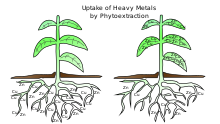
Phytomining, sometimes called agromining,[1] is the concept of extracting heavy metals from the soil using plants.[2] Specifically, phytomining is for the purpose of economic gain.[3] The approach exploits the existence of hyperaccumulators, proteins or compounds secreted by plants to bind certain metal ions. These extracted ores are called bio-ores.[4] A 2021 review concluded that the commercial viability of phytomining was "limited"[1] because it is a slow and inefficient process.
- ^ a b Dang, P.; Li, C. (2022-12-01). "A mini-review of phytomining". International Journal of Environmental Science and Technology. 19 (12): 12825–12838. Bibcode:2022JEST...1912825D. doi:10.1007/s13762-021-03807-z. ISSN 1735-2630.
- ^ Brooks, Robert R; Chambers, Michael F; Nicks, Larry J; Robinson, Brett H (1998-09-01). "Phytomining". Trends in Plant Science. 3 (9): 359–362. Bibcode:1998TPS.....3..359B. doi:10.1016/S1360-1385(98)01283-7. ISSN 1360-1385.
- ^ Linacre, J. Scott Angle and Nicholas A. (2005). Ecological Risks of Novel Environmental Crop Technologies Using Phytoremediation as an Example. Intl Food Policy Res Inst.
- ^ "Leaders of the energy transition are calling for a sustainable source of critical metals – is phytomining the answer?". smi.uq.edu.au. 2021-02-11. Retrieved 2023-10-09.